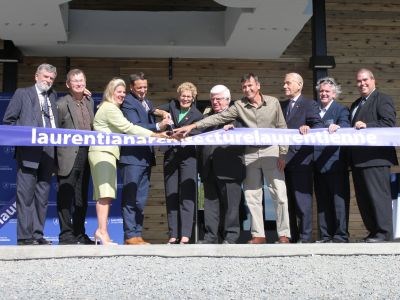“It’s not about being big; it’s about thinking big.”
With those words from Laurentian University president Dominic Giroux, Laurentian Architecture Laurentienne (LAL) opened its doors Sept. 4 to a throng of well-wishers and dignitaries eager to tour the new facility. The first cohort of 70 students, and its complement of faculty and staff, was set to start class this week.
Phase one of the Sudbury-based school—the first school of architecture to be established in Canada in 40 years—incorporates the city’s former farmers’ market and an old Canadian Pacific Railway telegraph building dating back to the early 1900s.
The school was designed by Levitt Goodman Architects of Toronto and constructed by Cy Rheault Construction of Timmins.
The meeting of past and future has been a recurring theme throughout the project’s development; Laurentian was originally located downtown—a mere block from the architecture school’s current location.
“Who would have thought we would be here opening a new school of architecture in downtown Sudbury after securing the unanimous support of the existing 11 Canadian schools of architecture, thanks to Mr. Blaine Nicholls, as well as $41 million from the three levels of government?” Giroux said.
Contributions included $10 million from the City of Greater Sudbury, $26 million from the province and $5 million from FedNor.
To recognize Nicholls, a driving force behind the project and the steering committee’s chair, Giroux announced Laurentian would bestow him with an honorary doctorate at a future convocation ceremony.
Even Ontario Premier Kathleen Wynne brought a little piece of history to the ceremony. Fred Rounthwaite, the father of her partner, Jane Rounthwaite, was one of the original architects who worked on Laurentian University, she revealed.
Wynne spoke of the architecture school as a “living laboratory,” where students would explore their dreams while designing infrastructure for Northern communities and preserving their Northern heritage by focusing on First Nations designs, working with an elder-in-residence and taking courses in French.
The premier expressed her hope that the students’ school experience would lead them to rewarding jobs and great opportunities in the North.
“I want you to be able to do what you love, pursue your interest and show off your skills without leaving the part of the province that means so much to you, if that’s what you choose to do,” she said. “And I want you to enter the Ontario workforce with the skills that you need and the confidence that you can do great things.”
“You will design the infrastructure that helps businesses and industries to expand, and you will help protect our environment with smart, sustainable designs,” Wynne added. “You will be part of the soul of Ontario’s civilization and you will contribute to the architecture of the North.”
Founding director Terrance Galvin noted that the “uncompromising vision” for the school began prior to 2007 and came to fruition thanks to the full support of the community, including downtown businesses that put up the money for the feasibility study.
“Today this vision becomes 100 per cent real as the Laurentian School of Architecture begins teaching its unique Northern curriculum that will celebrate the proud cultures and environment of Northern Ontario, including indigenous and francophone students and faculty members,” he said.
Upon opening his Elgin Street business 40 years ago, Michael Atkins (who owns Northern Ontario Business) said he underestimated the community’s power, determination, creativity and, most of all, its ability to renew itself to overcome any obstacles thrown in the way of learning and growing.
An idea for a school of architecture was originally proposed by Laurentian economics Prof. David Robinson during a meeting with the mayors of six small Northern Ontario communities that were facing the “catastrophic” closure of their lumber mills, Atkins said. Casting about for ideas, a school of industrial design and architecture was proposed as a way to connect the community in a more creative way with wood.
“So, not surprisingly, at all for Northern Ontario, this idea emerged from the pain and challenge of staying alive in this volatile resource economy,” said Atkins, chair of Laurentian’s board of governors.
“Northern Ontario and its economy require the capability to contemplate its surroundings, to utilize its riches and impact its future in a creative, confident way,” Atkins said. “The Laurentian School of Architecture, with its 70 new students from across the country and around the world, and its diversified faculty, are another piece in the puzzle, of bringing economic stability to Northern Ontario.”
Construction on the next phase of the building will get underway in late fall or early winter. Students will remain in the farmers’ market building for two years, while faculty and staff will work out of the telegraph building.
As construction is completed and the program expands—the student body is expected to grow to 400—the farmers’ market building will become workshop space where students can experiment with digital, wood, earth, straw, and rammed earth projects.
The school will also have a 150-metre setback to allow for the city’s Elgin Greenway project, a green transportation corridor linking the downtown, construction of which is set to get started this fall.
Earlier in the day, Wynne attended the opening of Lakehead University’s new law school. Proclaimed as Ontario's first law school in 44 years, the inaugural class of 60 students will focus on Aboriginal and natural resources law, and single or sole practitioner law.
“A new law school is opening that is different and that is intended to serve the communities in Northern Ontario and in smaller centres throughout Canada,” said Prof. Lee Stuesser, founding dean of the faculty of law, in a news release. “It is small; it is personal; and it is tailored to prepare students for professional practice.”
The school is expected to play a vital role for Aboriginal communities in northwestern Ontario for First Nation, Métis and Inuit communities.
The Ministry of Training, Colleges and Universities (MTCU) helped fund the law school with $1.5 million for capital improvements to the former high school in the city's north end.




